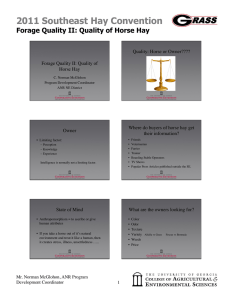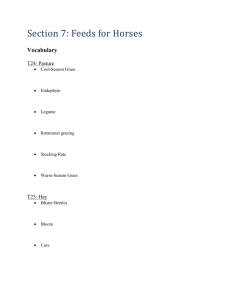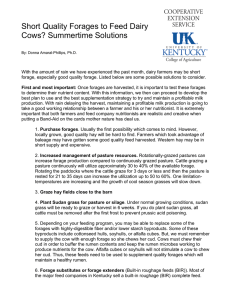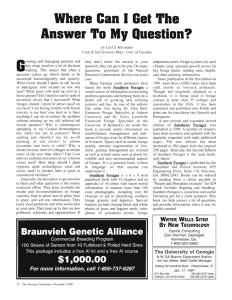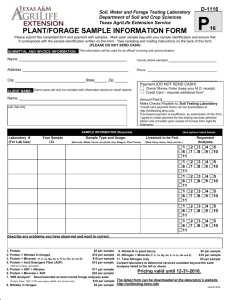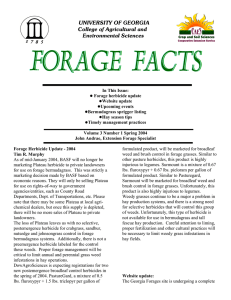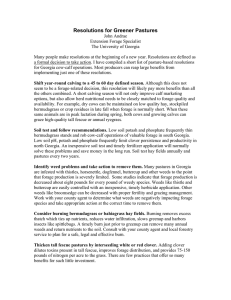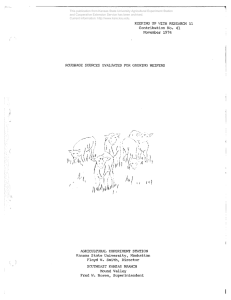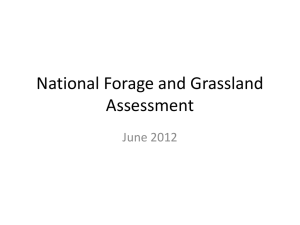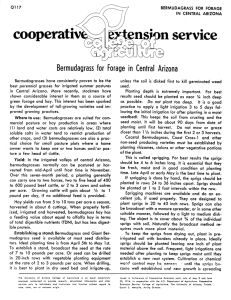Forages for Horses - Perquimans County Center
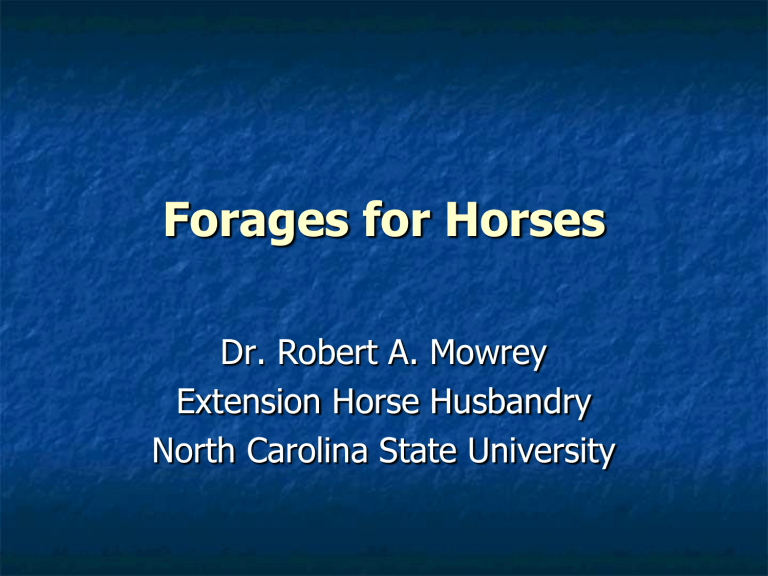
Forages for Horses
Dr. Robert A. Mowrey
Extension Horse Husbandry
North Carolina State University
Forage
The foundation of a horse’s feeding program
Provide grains and protein, mineral & vitamin supplements only when deficient in forage
The economical approach to feeding
Forages Suitable for
Equines
Legume
Grass
Cereal Grain
Mixed grass / legume
What is Quality Hay?
High in nutrient content
Eaten in large amounts
Palatable vs. acceptable
Appearance?
Factors Affecting Hay Quality
Stage of maturity
Leafiness vs. stem
Foreign material
Weeds
Debris
Other forages
Color
Condition and odor
Green Color “Means”
Cut at immature stage
Proper curing
High in carotene Vitamin A
Condition & Odor
Shake hay flake
White cloud = mold spores
Brown cloud = dusty hay
Avoid moldy hay
Feed refusal factor colic
Stage of Maturity
Cut forages early
Grasses- prior to seed head
Legumes- at 10% bloom
Nutrient content decreases with maturity
Grass field cut
Crude Fiber (CF)
June 3
29%
Crude Protein (CP) 15%
Digestible Energy (DE) 65%
June 27
40%
5%
50%
Effect of Maturity on
Digestibility
Immature plants
Thin cell wall
Cell contents- protein, sugar, fat, starch, pectin
Low CF
High CP; DE
Mature plants
Thick cell wall
Thin cell contents
High CF
Low DE, CP
Nutrient Content of Forages in Horse Diets 1
DM
(%)
DE CP
(Mcal/lb) (%)
ADF CF
(%) (%)
Orchardgrass fresh immature hay mature hay
Coastal Bermudagrass fresh immature hay mature hay
23.5
0.24
3.0
7.2
7.5
89.1
0.88 11.4
30.1
30.2
90.6
0.78
7.6
34.2
33.6
30.3
0.33
3.8
11.1
8.6
88.4
0.87 10.6
30.0
26.7
93.0
0.79
7.3
35.7
30.4
1 Nutrient Requirements of the Horse (1989). As fed basis.
Feed Testing Service
Conducted by NCDA & CS
$10.00 per sample
Test Kits
Free
Available at County Extension Office
Forage Protein Content
Hay
Legumes Red Clover
Alfalfa
Lespedeza
Timothy
Grasses Orchardgrass
Bermudagrass
Fescue
%CP % DP %Lysine
14.9
8.3
15.0
10.0
13.4
7.5
9.0
6.0
0.64
0.64
0.60
0.40
10.1
6.0
9.5
4.5
8.4
3.7
0.35
0.43
0.41
Forage Energy Content
Hay Mcal/kg
Legumes Red Clover
Alfalfa
Lespedeza
Timothy
Grasses Orchardgrass
Bermudagrass
Fescue
2.16
2.16
2.07
1.98
2.07
1.94
1.81
DE
TDN %
49
49
52
45
44
44
45
Ratio
Forage Mineral
Content
Hay %Ca % P Ca:P
Legumes Red Clover
Alfalfa
Lespedeza
Timothy
Grasses Orchardgrass
14.9
15.0
1.04
0.41
0.35
Bermudagrass 0.46
Fescue 0.36
0.25
0.25
0.23
0.19
0.31
0.18
0.21
6:1
6:1
4.5:1
2.15:1
1.1:1
2.5:1
1.7:1
Forage Fed as Hay vs. Grazed
Performance of Yearling
Horses on Pasture and
Supplemental Feed
Hansen et al. 1987, Texas A& M
University
Experiment Design
18 Yearlings, 295 kg Body Weight
188 day continuous grazing trial (March-
Sept)
Part 1= 56 days (ryegrass + bermudagrass); March-May
Part 2= 132 days (Bermuda); June- Oct
Stocking rate: 3.0 horses (700 lbs.)/acre
Treatments
PAS - pasture
1/2 Fed - pasture + grain (25% NRC energy)
Fed - pasture + grain (50% NRC energy)
Estimated Cost/Day
Pasture
Pasture + 1/2
Feed
Pasture + Full
Feed
$0.14
$0.58
$1.02
